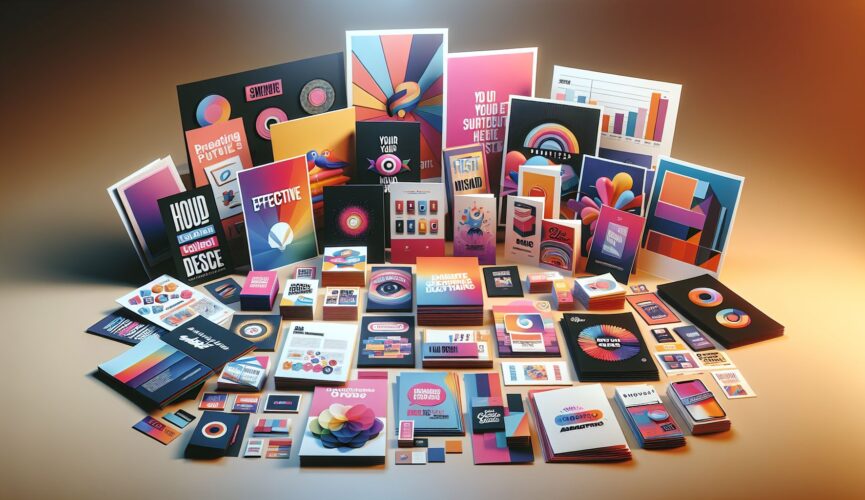In today’s digital age, it’s easy to overlook the importance of printed marketing materials. With the rise of online advertising, social media campaigns, and email marketing, companies often forget about the power of tangible, physical marketing materials. However, printed marketing materials such as brochures, business cards, posters, and flyers remain an essential component of a successful advertising strategy.
Printed marketing materials have been around for centuries and have stood the test of time. Even in the digital era, they continue to play a vital role in promoting businesses, connecting with customers, and reinforcing brand identity. While it’s important to embrace new technologies and leverage digital channels, it’s equally important not to neglect the tried and true method of printed marketing materials. Here, we will discuss why printed marketing materials are still relevant and how they can enhance your advertising campaigns.
The Power of Physical Presence
One of the main advantages of printed marketing materials is their physical presence. Unlike digital ads that can be easily ignored or forgotten, printed materials can grab the attention of your target audience and make a lasting impression. When well-designed and strategically placed, printed materials command attention and leave a stronger impact on potential customers.
Imagine attending a trade show or conference and coming across a beautifully designed booth with eye-catching banners, brochures neatly displayed, and business cards readily available. The physical presence of these materials makes it easier for potential customers to engage with your brand, take your information, and remember you even after the event. In this digital age, holding a tangible item with your brand’s logo and message can create a more memorable experience for your audience.
Tangible & Trustworthy
Printed marketing materials are tangible, which means they can be touched, felt, and experienced physically. This aspect creates a sense of trust and credibility for your brand. Research has shown that people perceive printed materials as more reliable compared to digital ads, which can sometimes be associated with spam or misinformation. By offering physical materials, you convey a sense of legitimacy and build trust with your audience.
For example, when receiving a well-designed and professionally printed brochure, customers are more likely to feel that your company is established and trustworthy. This perception can lead to increased brand loyalty and higher chances of conversion. By incorporating printed materials into your advertising campaigns, you demonstrate your commitment to quality and attention to detail, which can greatly influence consumer perception and purchasing decisions.
Enhanced Targeting and Personalization
Another advantage of printed marketing materials is the ability to target specific demographics and personalize the content. By carefully designing your printed materials and tailoring the message to your target audience, you can achieve better engagement and higher conversion rates. Unlike digital ads that can reach a broad audience, printed materials can be distributed strategically to specific locations or events where your target audience is more likely to be present.
For instance, if you are promoting a new fitness studio, distributing flyers in local gyms, health food stores, and community centers can effectively reach individuals interested in fitness and wellness. Similarly, by personalizing your business cards with individual contact information, you can create a more personalized and memorable interaction with potential clients or partners.
The ability to customize and personalize printed materials enables you to connect with your audience on a deeper level, fostering meaningful relationships and establishing a sense of loyalty and trust.
Versatility and Longevity
Printed marketing materials offer a wide range of versatility in terms of design, format, and distribution. From brochures, posters, and business cards to banners, catalogs, and direct mail campaigns, you have endless options to choose from based on your specific goals and target audience. This versatility allows you to tailor your advertising materials to be visually appealing, informative, and impactful.
Furthermore, printed materials have a longer lifespan compared to digital ads. A well-designed brochure, for example, can sit on someone’s desk for weeks or even months, serving as a constant reminder of your brand and its offerings. In contrast, a digital ad displayed on a website may disappear from view as soon as the user clicks away. The longevity of printed marketing materials contributes to their effectiveness in creating brand recognition and recall, especially when combined with other elements of your advertising strategy.
Measurable Impact
Contrary to popular belief, printed marketing materials are not only memorable and aesthetically pleasing but also measurable. By using trackable QR codes, specific landing pages, or unique phone numbers, you can measure the success of your printed materials and evaluate their impact on your campaigns. This allows you to gather data on customer behavior, track conversions, and make informed decisions for future marketing initiatives.
For example, by including a QR code on your printed material, you can direct customers to a specific webpage where they can explore your products further or make a purchase. This enables you to track the number of scans and conversions, providing valuable insights into the effectiveness of your printed materials in driving sales or generating leads.
Conclusion
In a digital era dominated by online advertising, it’s important not to overlook the power of printed marketing materials. The physical presence, tangibility, trustworthiness, and versatility of printed materials make them an invaluable component of any advertising campaign. By incorporating printed materials into your marketing strategy, you can command attention, build credibility, target specific demographics, personalize your message, and measure your impact.
Printed materials have stood the test of time and continue to generate results. They offer a unique opportunity to engage with your target audience in a more meaningful way and create lasting brand recognition. So, the next time you plan your advertising campaign, don’t forget about the enduring power of printed marketing materials.

